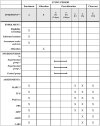Transcranial direct current stimulation to facilitate neurofunctional rehabilitation in children with autism spectrum disorder: a protocol for a randomized, sham-controlled, double-blind clinical trial
- PMID: 37396775
- PMCID: PMC10310925
- DOI: 10.3389/fneur.2023.1196585
Transcranial direct current stimulation to facilitate neurofunctional rehabilitation in children with autism spectrum disorder: a protocol for a randomized, sham-controlled, double-blind clinical trial
Abstract
Background: Anodal transcranial direct current stimulation (tDCS) over the primary motor cortex and cerebellum is gaining prominence in the literature due to its potential to favor learning and motor performance. If administered during motor training, tDCS is capable of increasing the effect of training. Considering the motor impairment presented by children with Autism Spectrum Disorders (ASD), atDCS applied during motor training may contribute to the rehabilitation of these children. However, it is necessary to examine and compare the effects of atDCS over the motor cortex and the cerebellum on the motor skills of children with ASD. This information may benefit future clinical indications of tDCS for rehabilitation of children with ASD. The aim of the proposed study is to determine whether anodal tDCS over the primary motor cortex and cerebellum can enhance the effects of gait training and postural control on motor skills, mobility, functional balance, cortical excitability, cognitive aspects and behavioral aspects in children with ASD. Our hypothesis is the active tDCS combined with motor training will enhance the performance of the participants in comparison to sham tDCS.
Methods and design: A randomized, sham-controlled, double-blind clinical trial will be conducted involving 30 children with ASD that will be recruited to receive ten sessions of sham or ten sessions of active anodal tDCS (1 mA, 20 min) over the primary motor cortex or cerebellun combined with motor training. The participants will be assessed before as well as one, four and eight weeks after the interventions. The primary outcome will be gross and fine motor skills. The secondary outcomes will be mobility, functional balance, motor cortical excitability, cognitive aspects and behavioral aspects.
Discussion: Although abnormalities in gait and balance are not primary characteristics of ASD, such abnormalities compromise independence and global functioning during the execution of routine activities of childhood. If demonstrated that anodal tDCS administered over areas of the brain involved in motor control, such as the primary motor cortex and cerebellum, can enhance the effects of gait and balance training in only ten sessions in two consecutive weeks, the clinical applicability of this stimulation modality will be expanded as well as more scientifically founded.Clinical trial registration February 16, 2023 (https://ensaiosclinicos.gov.br/rg/RBR-3bskhwf).
Keywords: autism spectrum disorder; balance; child; gait; physical therapy; transcranial direct current stimulation.
Copyright © 2023 Araujo, Tamplain, Duarte, Comodo, Ferreira, Queiróga, Oliveira and Collange-Grecco.
Conflict of interest statement
The authors declare that the research was conducted in the absence of any commercial or financial relationships that could be construed as a potential conflict of interest.
Figures


References
LinkOut - more resources
Full Text Sources

